Impacts from Waste Oyster Shell on the Durability and Biological Attachment of Recycled Aggregate Porous Concrete for Artificial Reef
Abstract
:1. Introduction
2. Materials and Methods
2.1. Raw Materials and Preparation Procedures
- (1)
- The WOS powder and cement were firstly mixed in the concrete mixer for 30s;
- (2)
- Water reducing agent was dissolved in the water and then to add and mix in the concrete mixer for 60s;
- (3)
- The recycled aggregate was mixed with the above cement paste for 90s to get the fresh concrete;
- (4)
- The prepared RAPC was cast into the molds and subsequently removed from the molds after 1d;
- (5)
- The specimens were cured at a temperature of 20 ± 2 °C and humidity of 95% RH.
2.2. Test Methods
2.2.1. Mechanical Properties
2.2.2. Durability
Chloride Penetration Resistance
Freezing-Thawing Resistance
Low Temperature Resistance
2.2.3. Biological Attachment
Testing Program
Assessment Methods of Biological Attachment
2.2.4. Carbon Dioxide Emission
3. Results and Discussion
3.1. Mechanical Properties
3.2. Durability
3.2.1. Chloride Penetration Resistance
3.2.2. Freezing–Thawing Resistance
3.2.3. Low Temperature Resistance
3.3. Biological Attachments Analysis
3.3.1. Biological Attachment Density
3.3.2. Assessment of Attached Biological Attachment
3.4. Carbon Dioxide Emission
4. Conclusions
- (1)
- The addition of WOS can decrease the compressive and split tensile strength, but the effect of designed porous structure on the mechanical strength is higher than that of WOS.
- (2)
- To ensure the durability of RAPC, the contents of WOS should not exceed 20%.
- (3)
- The addition of WOS and designed porous structures are beneficial to the improvement of biological attachment. However, the porous structure of RAPC only improves biological attachment in the short term, and the reverse phenomenon is true in the long term.
- (4)
- As the partial replacement of cement with WOS is 40%, the total carbon dioxide emission decreases by about 52%.
Author Contributions
Funding
Acknowledgments
Conflicts of Interest
References
- Huang, B.; Wang, X.; Kua, H.; Geng, Y.; Bleischwitz, R.; Ren, J. Construction and demolition waste management in China through the 3R principle. Resour. Conserv. Recycl. 2018, 129, 36–44. [Google Scholar] [CrossRef]
- Luhar, S.; Cheng, T.-W.; Luhar, I. Incorporation of natural waste from agricultural and aquacultural farming as supplementary materials with green concrete: A review. Compos. Part B Eng. 2019, 175, 107076. [Google Scholar] [CrossRef]
- Shi, C.J.; Wu, Z.M.; Cao, Z.J.; Ling, T.C.; Zheng, J.L. Performance of mortar prepared with recycled concrete aggregate en-hanced by CO2 and pozzolan slurry. Cem. Concr. Compos. 2018, 86, 130–138. [Google Scholar] [CrossRef]
- Zhang, Y.; Luo, W.; Wang, J.; Wang, Y.; Xu, Y.; Xiao, J. A review of life cycle assessment of recycled aggregate concrete. Constr. Build. Mater. 2019, 209, 115–125. [Google Scholar] [CrossRef]
- Liu, L.; Li, Z.; Cai, G.; Geng, X.; Dai, B. Performance and prediction of long-term settlement in road embankments constructed with recycled construction and demolition waste. Acta Geotech. 2022, 1–25. [Google Scholar] [CrossRef]
- Behera, M.; Bhattacharyya, S.; Minocha, A.; Deoliya, R.; Maiti, S. Recycled aggregate from C&D waste & its use in concrete—A breakthrough towards sustainability in construction sector: A review. Constr. Build. Mater. 2014, 68, 501–516. [Google Scholar] [CrossRef]
- McNeil, K.; Kang, T.H.-K. Recycled concrete aggregates: A review. Int. J. Concr. Struct. Mater. 2013, 7, 61–69. [Google Scholar] [CrossRef]
- Xiao, J.; Li, L.; Shen, L.; Poon, C.S. Compressive behaviour of recycled aggregate concrete under impact loading. Cem. Concr. Res. 2015, 71, 46–55. [Google Scholar] [CrossRef]
- Li, L.; Chen, M.; Zhou, X.; Lu, L.; Wang, Y.; Cheng, X. Evaluation of the preparation and fertilizer release performance of planting concrete made with recycled-concrete aggregates from demolition. J. Clean. Prod. 2018, 200, 54–64. [Google Scholar] [CrossRef]
- Kong, J.; Cong, G.; Ni, S.; Sun, J.; Guo, C.; Chen, M.; Quan, H. Recycling of waste oyster shell and recycled aggregate in the porous ecological concrete used for artificial reefs. Constr. Build. Mater. 2022, 323, 126447. [Google Scholar] [CrossRef]
- Li, L.F.; Zeng, Z.Q.; Wang, Z.F.; Peng, Z.; She, X.D.; Li, S.D.; Zhong, J.P. Effect of Oyster Shell Powder Loading on the Me-chanical and Thermal Properties of Natural Rubber/Oyster Shell Composites. Polym. Polym. Compos. 2017, 25, 17–22. [Google Scholar]
- Yang, E.I.; Yi, S.-T.; Leem, Y.-M. Effect of oyster shell substituted for fine aggregate on concrete characteristics: Part I. Fundamental properties. Cem. Concr. Res. 2005, 35, 2175–2182. [Google Scholar] [CrossRef]
- Yoon, G.-L.; Kim, B.-T.; Kim, B.-O.; Han, S.-H. Chemical–mechanical characteristics of crushed oyster-shell. Waste Manag. 2003, 23, 825–834. [Google Scholar] [CrossRef]
- Sutton, S.G.; Bushnell, S.L. Socio-economic aspects of artificial reefs: Considerations for the Great Barrier Reef Marine Park. Ocean Coast. Manag. 2007, 50, 829–846. [Google Scholar] [CrossRef]
- Thakur, I.S.; Kumar, M.; Varjani, S.J.; Wu, Y.; Gnansounou, E.; Ravindran, S. Sequestration and utilization of carbon dioxide by chemical and biological methods for biofuels and biomaterials by chemoautotrophs: Opportunities and challenges. Bioresour. Technol. 2018, 256, 478–490. [Google Scholar] [CrossRef]
- Ma, M.; Tam, V.W.Y.; Le, K.N.; Osei-Kyei, R. Factors affecting the price of recycled concrete: A critical review. J. Build. Eng. 2022, 46, 103743. [Google Scholar] [CrossRef]
- Becker, A.; Taylor, M.D.; Folpp, H.; Lowry, M.B. Managing the development of artificial reef systems: The need for quantitative goals. Fish Fish. 2018, 19, 740–752. [Google Scholar] [CrossRef]
- Seaman, W. Artificial habitats and the restoration of degraded marine ecosystems and fisheries. In Biodiversity in Enclosed Seas and Artificial Marine Habitats; Springer: New York, NY, USA, 2007; pp. 143–155. [Google Scholar]
- Ly, O.; Yoris-Nobile, A.I.; Sebaibi, N.; Blanco-Fernandez, E.; Boutouil, M.; Castro-Fresno, D.; Hall, A.E.; Herbert, R.J.; Deboucha, W.; Reis, B.; et al. Optimisation of 3D printed concrete for artificial reefs: Biofouling and mechanical analysis. Constr. Build. Mater. 2021, 272, 121649. [Google Scholar] [CrossRef]
- Chlayon, T.; Iwanami, M.; Chijiwa, N. Impacts from concrete microstructure and surface on the settlement of sessile organisms affecting chloride attack. Constr. Build. Mater. 2020, 239, 117863. [Google Scholar] [CrossRef]
- Li, L.G.; Feng, J.-J.; Zhu, J.; Chu, S.-H.; Kwan, A.K.H. Pervious concrete: Effects of porosity on permeability and strength. Mag. Concr. Res. 2021, 73, 69–79. [Google Scholar] [CrossRef]
- Thomas, C.; Setién, J.; Polanco, J.A.; Alaejos, P.; de Juan, M.S. Durability of recycled aggregate concrete. Constr. Build. Mater. 2013, 40, 1054–1065. [Google Scholar] [CrossRef]
- Wang, L.; Jin, M.; Guo, F.; Wang, Y.; Tang, S. Pore Structural and Fractal Analysis of the Influence of FLY ASH and Silica Fume on the Mechanical Property and Abrasion Resistance of Concrete. Fractals 2021, 29, 2140003. [Google Scholar] [CrossRef]
- Zhang, G.F.; Wang, S.X.; Wang, B.; Zhao, Y.J.; Kang, M.; Wang, P.M. Properties of pervious concrete with steel slag as ag-gregates and different mineral admixtures as binders. Constr. Build. Mater. 2020, 257, 119543. [Google Scholar] [CrossRef]
- Petrounias, P.; Giannakopoulou, P.P.; Rogkala, A.; Kalpogiannaki, M.; Laskaris, N.; Lampropoulou, P.; Mouzakis, P.; Panag-iotaras, D.; Koukouzas, N. Sustainable Use of By-Products and Wastes from Greece to Produce Innovative Eco-Friendly Per-vious Concrete. Appl. Sci. 2022, 12, 5861. [Google Scholar] [CrossRef]
- Li, L.; Zhang, H.; Zhou, X.; Chen, M.; Lu, L.; Cheng, X. Effects of super absorbent polymer on scouring resistance and water retention performance of soil for growing plants in ecological concrete. Ecol. Eng. 2019, 138, 237–247. [Google Scholar] [CrossRef]
- Wu, H.; Sun, B.; Li, Z.; Yu, J. Characterizing thermal behaviors of various pavement materials and their thermal impacts on ambient environment. J. Clean. Prod. 2017, 172, 1358–1367. [Google Scholar] [CrossRef]
- Neville, A.M.; Brooks, J.J. Concrete Technology; Longman Scientific & Technical England: New York, NY, USA, 1987; Volume 438. [Google Scholar]
- Reddy, M.S.; Dinakar, P.; Rao, B.H. Mix design development of fly ash and ground granulated blast furnace slag based geo-polymer concrete. J. Build. Eng. 2018, 20, 712–722. [Google Scholar] [CrossRef]
- GB/T50081; Standard for Test Methods of Concrete Physical and Mechanical Properties. Standardization Administration of China: Beijing, China, 2019. (In Chinese)
- GB/T50082; Standard for Test Methods of Long-Term Performance and Durability of Ordinary Concrete. Standardization Ad-ministration of China: Beijing, China, 2009. (In Chinese)
- ASTMC1202; Standard Test Method for Electrical Indication of Concrete’s Ability to Resist Chloride Ion Penetration. ASTM International: West Conshohocken, PA, USA, 1997.
- Li, J.; Gong, P.; Guan, C.; Liu, Y. Carbon Sequestration of Additives of Artificial Reefs and Its Effect on Carbon Fixation of Ostrea Plicatula Gmelin. Prog. Fish. Sci. 2016, 37, 100–104. (In Chinese) [Google Scholar]
- Li, C.; Cui, S.; Nie, Z.; Gong, X.; Wang, Z.; Itsubo, N. The LCA of Portland cement production in China. Int. J. Life Cycle Assess. 2015, 20, 117–127. [Google Scholar] [CrossRef]
- Ding, N.; Yang, J. Life cycle inventory analysis of fossil energy in China. China Environ. Sci. 2015, 35, 1592–1600. (In Chinese) [Google Scholar]
- GB/T51366; Standard for Building Carbon Emission Calculation. Standardization Administration of China: Beijing, China, 2019. (In Chinese)
- Xiao, J.; Li, A.; Ding, T. Life cycle assessment on CO2 emission for recycled aggregate concrete. J. Southeast Univ. 2016, 46, 1088–1092. (In Chinese) [Google Scholar]
- Wang, Z.; Zou, D.; Liu, T.; Zhou, A. Influence of paste coating thickness on the compressive strength, permeability, and mesostructure of permeable concrete. Constr. Build. Mater. 2021, 299, 123994. [Google Scholar] [CrossRef]
- Morandeau, A.; Thiéry, M.; Dangla, P. Investigation of the carbonation mechanism of CH and C-S-H in terms of kinetics, microstructure changes and moisture properties. Cem. Concr. Res. 2014, 56, 153–170. [Google Scholar] [CrossRef]
- Dyer, T. Concrete Durability; CRC Press: New York, NY, USA, 2014. [Google Scholar]
- García-González, J.; Rodríguez-Robles, D.; Juan-Valdés, A.; Morán-del Pozo, J.M.; Guerra-Romero, M.I. Pre-Saturation Technique of the Recycled Aggregates: Solution to the Water Absorption Drawback in the Recycled Concrete Manufacture. Materials 2014, 7, 6224–6236. [Google Scholar] [CrossRef] [Green Version]
- Powers, T.C. The physical structure and engineering properties of concrete. Sci. Eng. Med. 1958, 178, 188. [Google Scholar]
- Tran, T.H.; Govin, A.; Guyonnet, R.; Grosseau, P.; Lors, C.; Garcia-Diaz, E.; Damidot, D.; Deves, O.; Ruot, B. Influence of the intrinsic characteristics of mortars on biofouling by Klebsorrnidium flaccidum. Int. Biodeterior. Biodegrad. 2012, 70, 31–39. [Google Scholar] [CrossRef]
- Borderie, F.; Alaoui-Sossé, B.; Aleya, L. Heritage materials and biofouling mitigation through UV-C irradiation in show caves: State-of-the-art practices and future challenges. Environ. Sci. Pollut. Res. 2015, 22, 4144–4172. [Google Scholar] [CrossRef]
- Flemming, H.-C.; Wingender, J.; Szewzyk, U.; Steinberg, P.; Rice, S.A.; Kjelleberg, S. Biofilms: An emergent form of bacterial life. Nat. Rev. Microbiol. 2016, 14, 563–575. [Google Scholar] [CrossRef]
- McDougald, D.; Rice, S.A.; Barraud, N.; Steinberg, P.D.; Kjelleberg, S. Should we stay or should we go: Mechanisms and ecological consequences for biofilm dispersal. Nat. Rev. Genet. 2012, 10, 39–50. [Google Scholar] [CrossRef]
- Billings, N.; Birjiniuk, A.; Samad, T.S.; Doyle, P.S.; Ribbeck, K. Material properties of biofilms-a review of methods for under-standing permeability and mechanics. Rep. Prog. Phys. 2015, 78, 036601. [Google Scholar] [CrossRef] [Green Version]
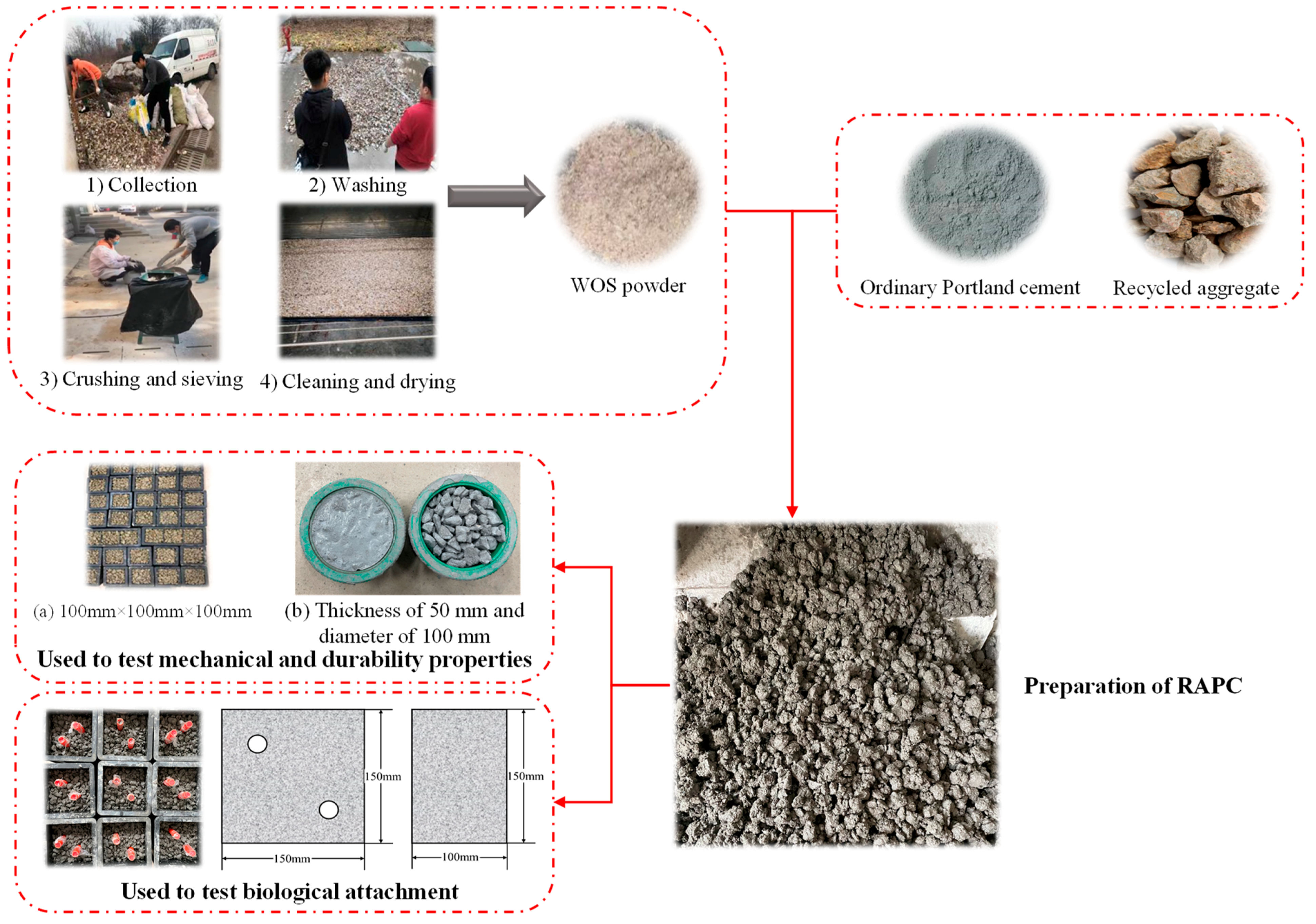

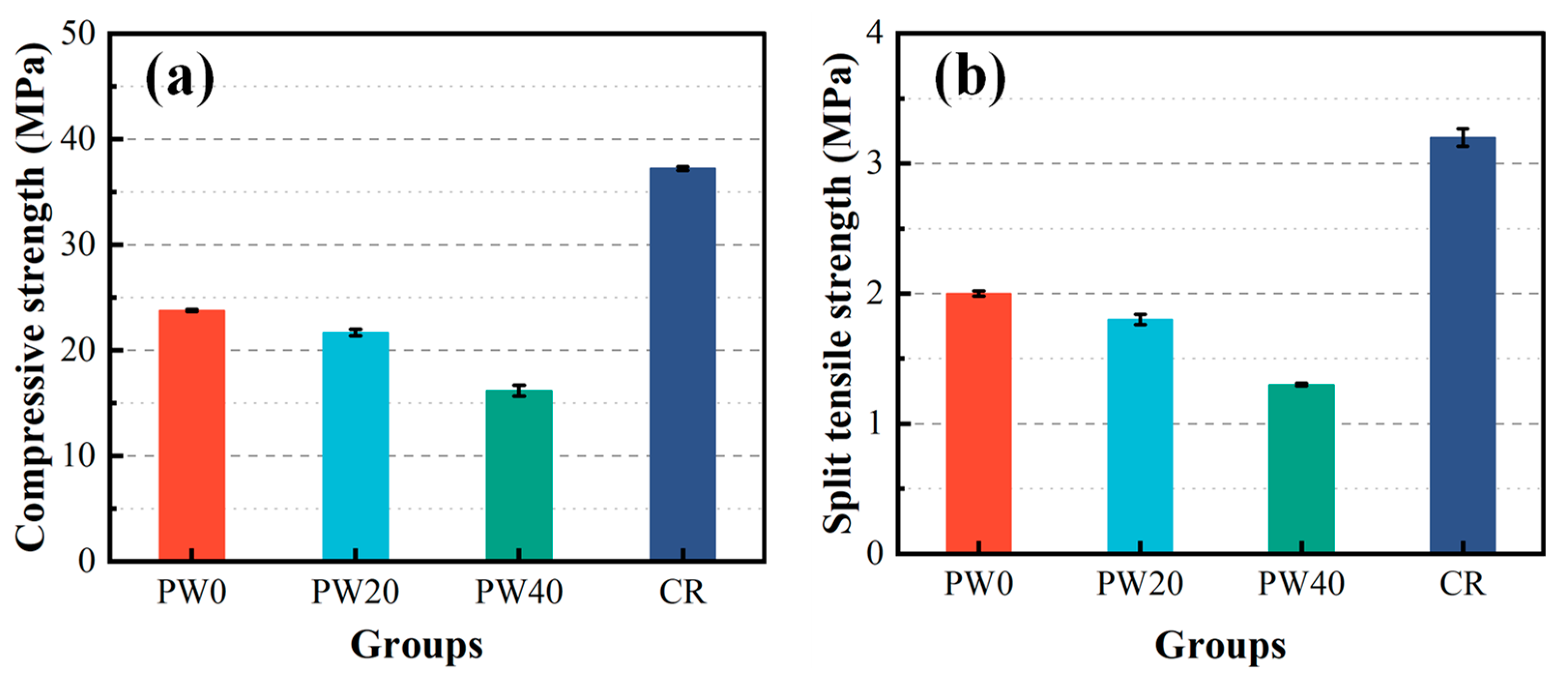
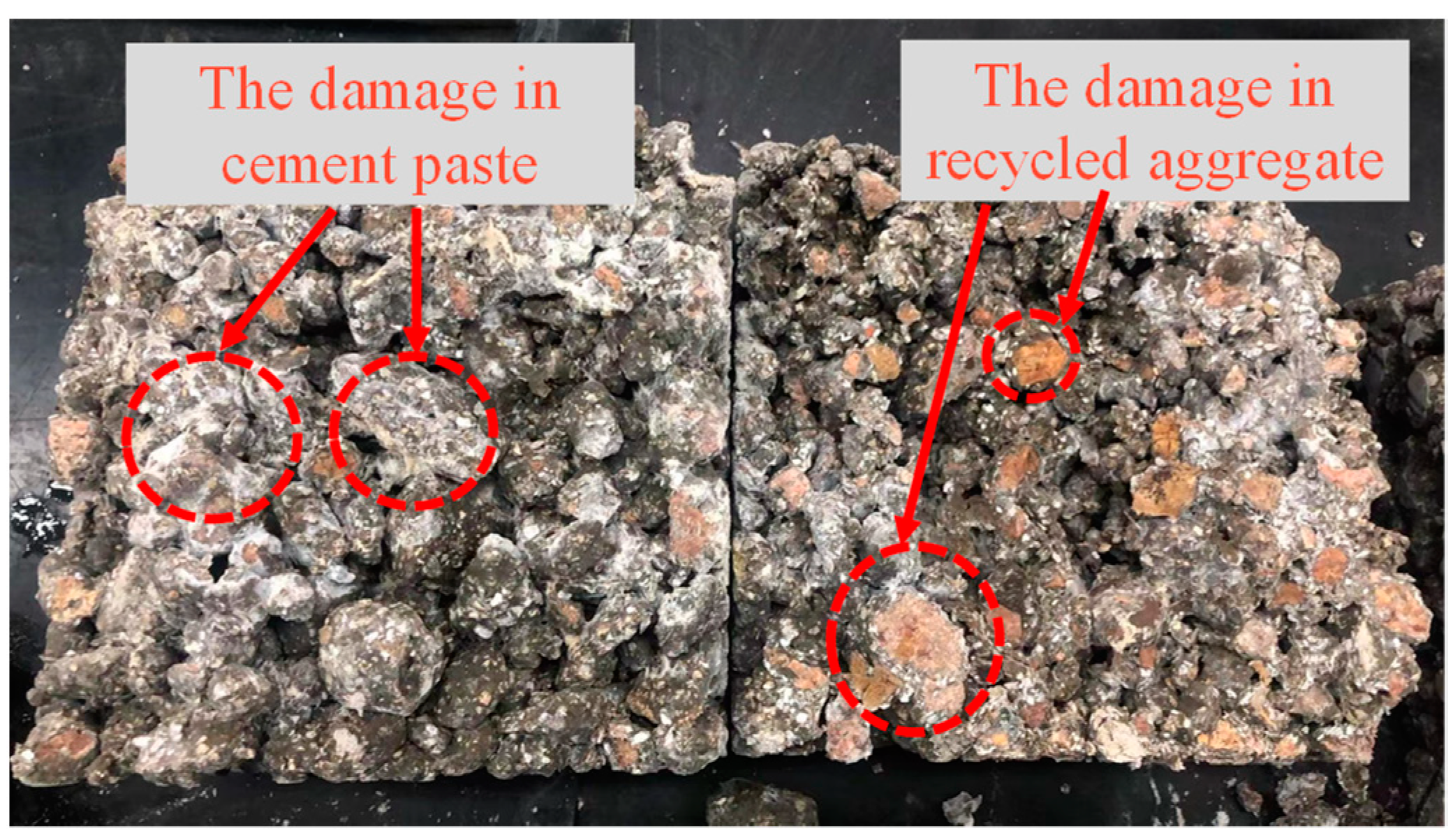



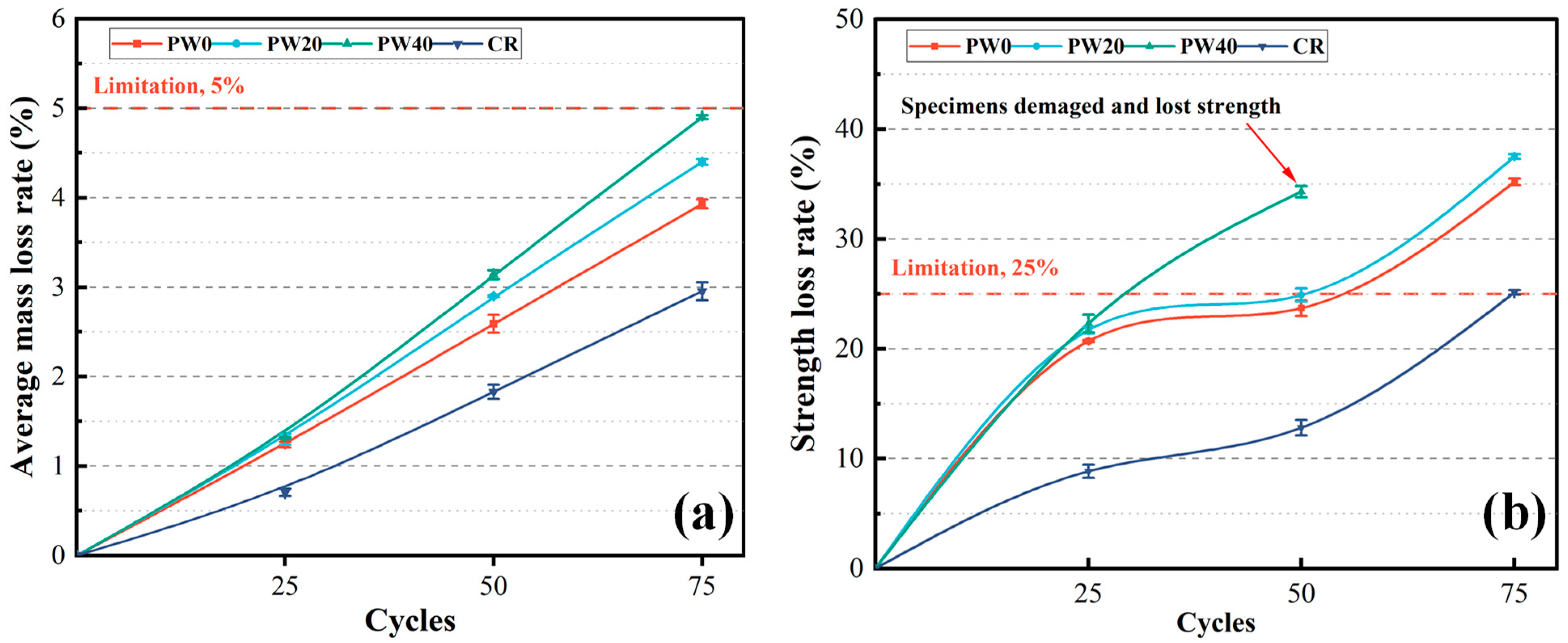
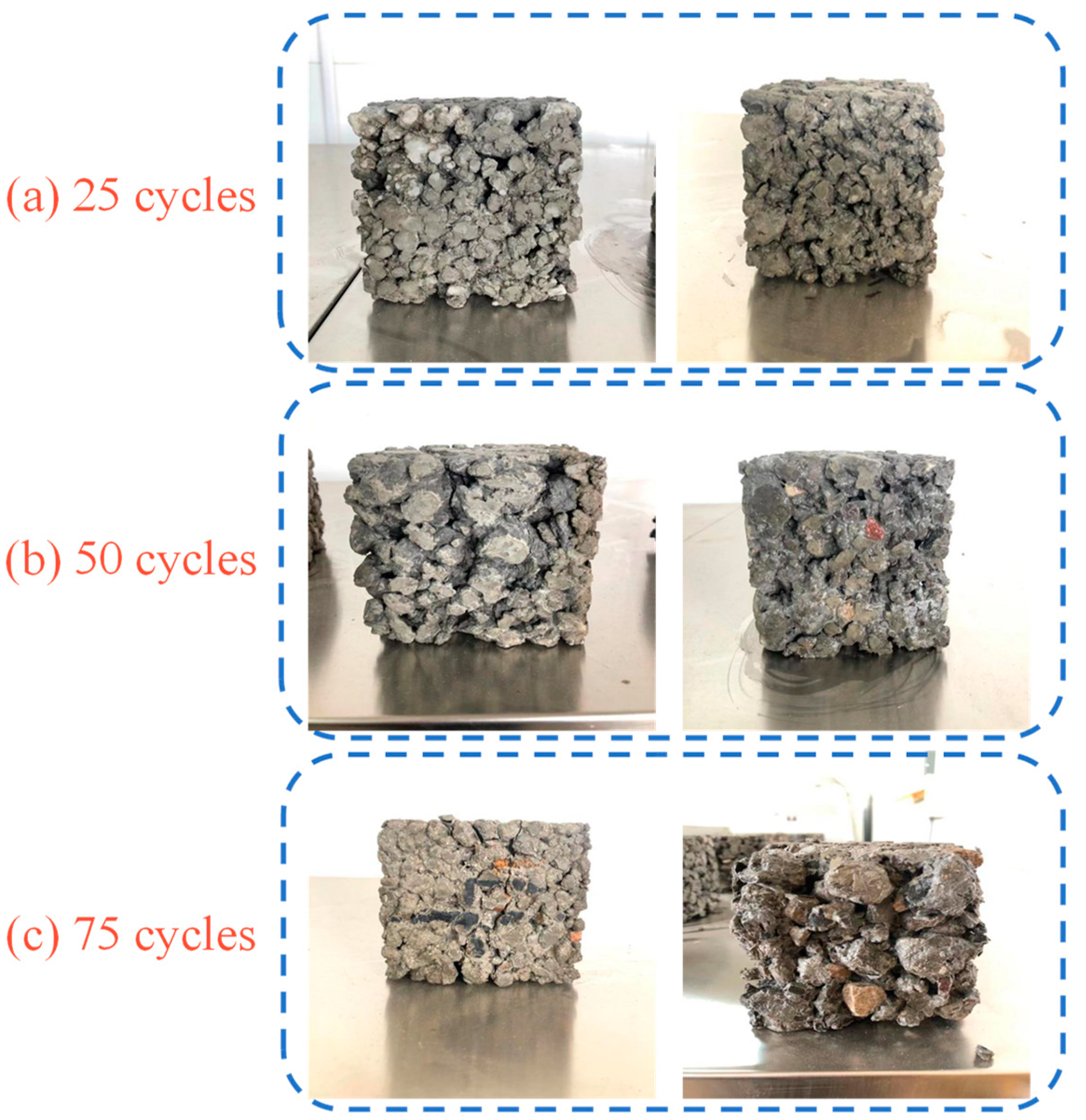


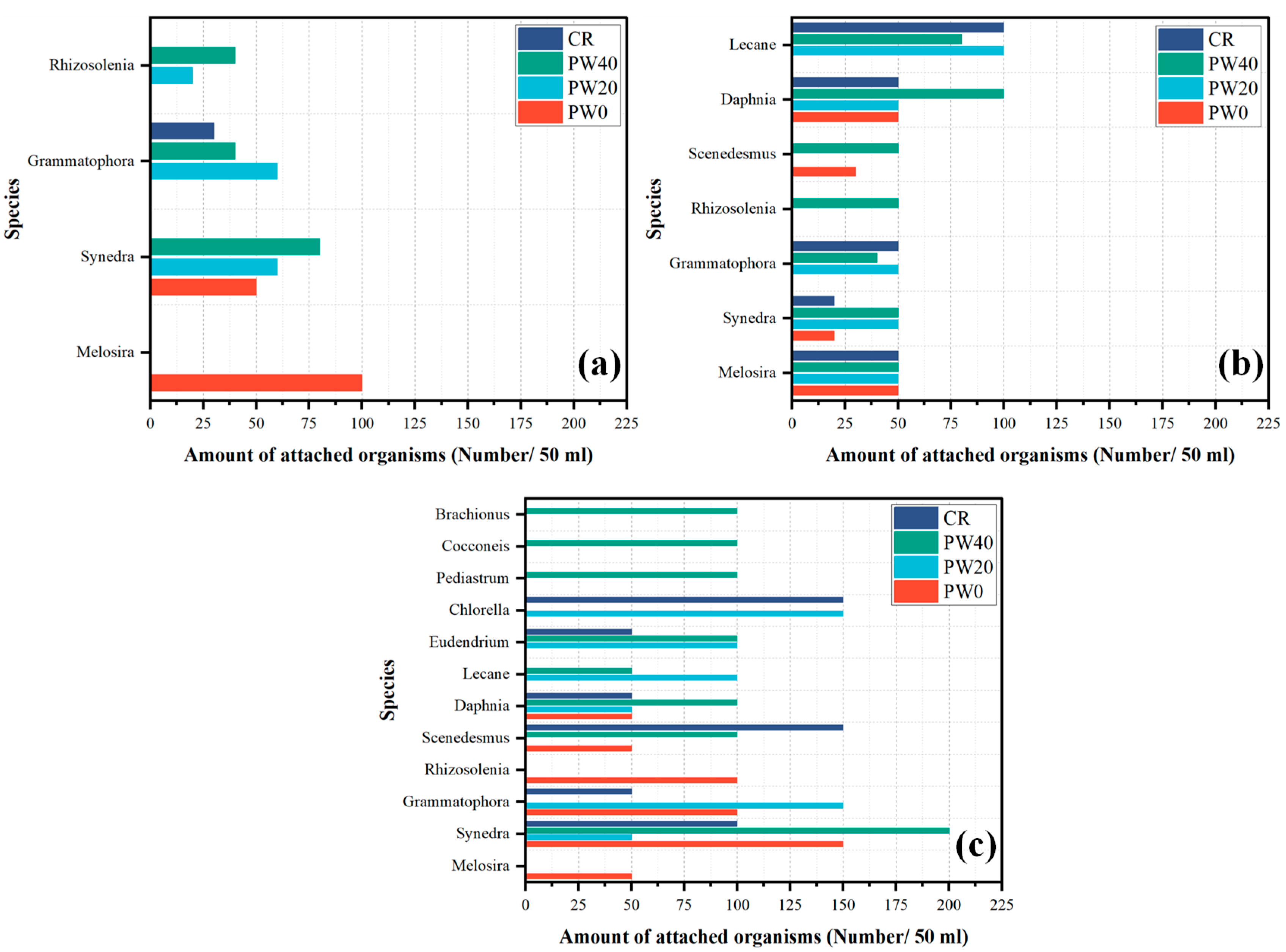
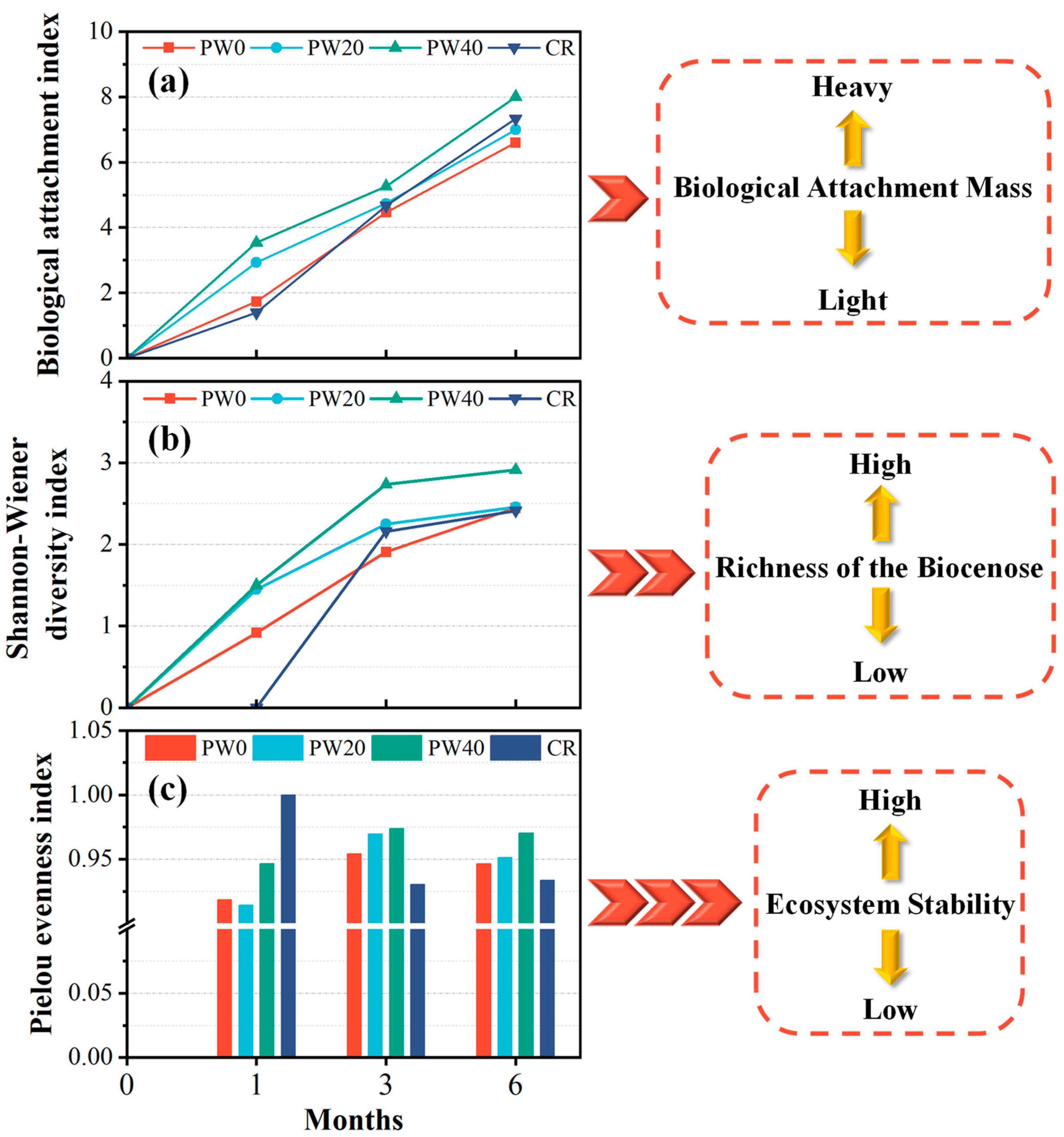

| Type | Density (kg/m3) | Specific Surface Area (m2/kg) | Setting Time (min) | Flexural Strength (MPa) | Compressive Strength (MPa) | |||
|---|---|---|---|---|---|---|---|---|
| Initial Setting Time | Final Setting Time | 3d | 28d | 3d | 28d | |||
| OPC | 3100 | 342 | 182 | 251 | 4.7 | 7.5 | 21.8 | 47.6 |
| WOS | 2850 | 313 | - | - | - | - | - | - |
| Material | SiO2 | AI2O3 | Fe2O3 | CaO | MgO | SO3 | Na2O | LOI |
|---|---|---|---|---|---|---|---|---|
| OPC | 21.31 | 5.68 | 3.54 | 61.72 | 1.3 | 2.58 | 2.89 | 1.05 |
| WOS | 1.05 | 0.21 | 0.27 | 95.06 | 0.67 | 0.56 | 1.28 | 0.91 |
| Material | Aggregate Size (mm) | Stacking Density (kg/m3) | Apparent Density (kg/m3) | Water Absorption (%) | crushing Index (%) |
|---|---|---|---|---|---|
| RA | 5-20 | 1420 | 2623 | 5.2 | 14 |
| Specimen | Replacement Rate (%) | Unit Weight (kg) | |||||
|---|---|---|---|---|---|---|---|
| Cement | Water | RA | WOS | Water Reducer | Sand | ||
| PW0 | 0 | 559 | 168 | 1598 | - | 0.6 | - |
| PW20 | 20 | 445 | 167 | 1598 | 111 | 1.3 | - |
| PW40 | 40 | 333 | 167 | 1598 | 222 | 1.7 | - |
| CR | 0 | 461 | 175 | 1252 | - | 1.4 | 512 |
| Energy | Total Carbon Dioxide Emissions (kg CO2-eq) | Note |
|---|---|---|
| Electricity (1 kW·h) | 1.195 | The data is derived from the IPCC and literature [34]. |
| Coal (1 kg) | 2.618 | It is obtained by data conversion from the literature [35]. |
| Diesel (1 L) | 3.178 | It is obtained by data conversion from the literature [35]. |
| Species | Total Carbon Dioxide Emissions (kg CO2-eq/t) | Note |
|---|---|---|
| Cement | 735 | The data is derived from GB/T 51,366 [36]. |
| Water | 0.347 | It is obtained by data conversion from the literature [37]. |
| Water reducer | 30.39 | It is obtained by data conversion from the literature [37]. |
| RA | 1.36 | It is obtained by data conversion from the literature [37]. |
| Sand | 2.51 | The data is derived from GB/T 51,366 [36]. |
| Species | Content | Note | |
|---|---|---|---|
| WOS | Processing WOS | ||
| Crushing (kW·h) | 4.41 | The power of crusher is 3 kW, and the efficiency of machine is 680 kg/h. | |
| Sieving (kW·h) | 1.6 | The power of screening equipment is 8 kW, and the machining efficiency is 5000 kg/h. | |
| Carbon dioxide emissions factor (kg CO2-eq/t) | 7.18 | Calculated by Table 5. | |
| Transporting WOS | |||
| Distance (km) | 15 | Transportation distance from collection place to laboratory. | |
| Carbon dioxide emissions factor (kg CO2-eq/t) | 5.01 | Diesel truck is used to transport, and its carbon dioxide emissions factor is 0.334 [kg CO2-eq/(t·km)] [36]. | |
| Total Carbon dioxide emissions factor (kg CO2-eq/t) | 12.19 | - | |
| Groups | PW0 | PW20 | PW40 | CR |
|---|---|---|---|---|
| RT-S | 0.084 | 0.083 | 0.080 | 0.086 |
Publisher’s Note: MDPI stays neutral with regard to jurisdictional claims in published maps and institutional affiliations. |
© 2022 by the authors. Licensee MDPI, Basel, Switzerland. This article is an open access article distributed under the terms and conditions of the Creative Commons Attribution (CC BY) license (https://creativecommons.org/licenses/by/4.0/).
Share and Cite
Kong, J.; Ni, S.; Guo, C.; Chen, M.; Quan, H. Impacts from Waste Oyster Shell on the Durability and Biological Attachment of Recycled Aggregate Porous Concrete for Artificial Reef. Materials 2022, 15, 6117. https://doi.org/10.3390/ma15176117
Kong J, Ni S, Guo C, Chen M, Quan H. Impacts from Waste Oyster Shell on the Durability and Biological Attachment of Recycled Aggregate Porous Concrete for Artificial Reef. Materials. 2022; 15(17):6117. https://doi.org/10.3390/ma15176117
Chicago/Turabian StyleKong, Jiafeng, Songyuan Ni, Chen Guo, Mingxu Chen, and Hongzhu Quan. 2022. "Impacts from Waste Oyster Shell on the Durability and Biological Attachment of Recycled Aggregate Porous Concrete for Artificial Reef" Materials 15, no. 17: 6117. https://doi.org/10.3390/ma15176117
APA StyleKong, J., Ni, S., Guo, C., Chen, M., & Quan, H. (2022). Impacts from Waste Oyster Shell on the Durability and Biological Attachment of Recycled Aggregate Porous Concrete for Artificial Reef. Materials, 15(17), 6117. https://doi.org/10.3390/ma15176117






